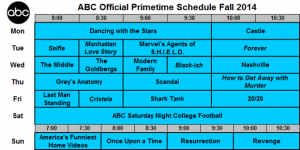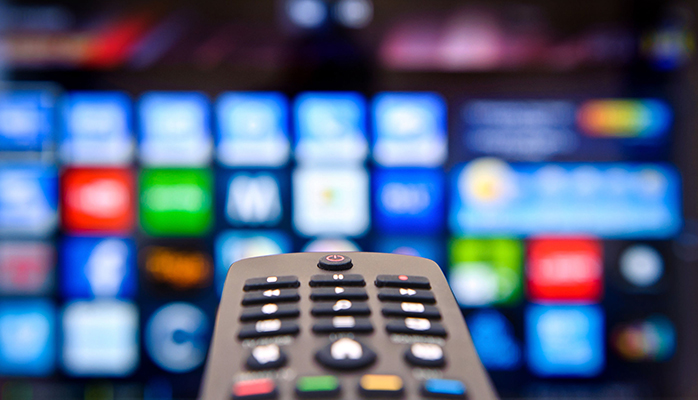Think like a TV network executive when programming your brand’s media channel to increase your ratings.
Once upon a time, when America’s media consumption was limited to three television stations, network executives would gather in a conference room each year to look at programming boards that looked like this:

Countless factors over months of audience testing were considered to determine how to get and keep an audience for each night of its most profitable programming.
Today, even though every brand can be its own media channel complete with its own programming, the basics of programming content haven’t changed since the Don Drapers of the world bought 30-second commercials on Gunsmoke, even though the channels to deliver that content in 2019 are overwhelming.
Here are a few ideas to make it easier.
For starters, think of a “branded channel” as your network: ABC, CBS, NBC, CNN, Fox, etc. All of the comedies, news, documentaries, dramas and reality shows that appear are the content on your channel, except the content most companies produce are more like social media, not Seinfeld; blogs instead of Bonanza, and; e-mail, not Ellen.
“But I don’t have the budget of a multi-media corporation,” you say, and that’s true enough. The good news is you don’t have to have a multi-million dollar budget if you follow the directives TV execs have been using for decades.
Cross-promote your content. You know how when you are watching a TV show on a particular network, and you see a commercial for another show on the same network? That’s called cross-promotion, and every network does it to keep their viewers tuned in. Companies can do the same thing on their “branded channels.” The simplest example is promoting the latest website blog post on Facebook or Twitter. Not all Facebook page fans ever visit a company’s website, and not every follower on Twitter is a fan on Facebook. By cross-promoting, the potential audience increases.
Own your niche audience. If you are older than 30, you remember NBC’s powerful Thursday night lineup, dubbed “Must See TV.” From 8:00 p.m. – 11:00 p.m. in 1996, the lineup was: Friends, The Single Guy, Seinfeld, Suddenly Susan and ER.” At least three of those shows would have been monumental hits whatever night they aired, but if you look at the lineup through a programming lens, you can almost imagine yourself in the boardroom as they discuss, “How can we dominate an urban, white, 18-40 audience with our programming?”
Likewise, look at the current CBS Sunday night lineup, which includes 60 Minutes, God Friended Me, NCIS and Madam Secretary. It doesn’t take a Ph.D. to realize why one of CBS’s monikers has been “The Tiffany Network.” They want to dominate the 50+ demographic, and I bet pharmaceutical companies spend hundreds of millions of dollars advertising their products during these shows because they know they have a captured audience that’s their target bullseye.
The same principle applies to your (albeit much smaller) network audience. If you’re in the HVAC business in Butte, for example, your content needs to appeal to homeowners, most likely over the age of 40, so showing off videos of your service techs doing poptarts on a snowboard halfpipe is a misalignment. Same goes for the ride-share industry. I can guarantee Lyft will never start a social media meme about car crashes.
Analytics tools can help solve some of the mystery. One of the most critical terms of art in the TV business is called the “overnights,” which tells executives how many people watched each show the previous day. On the Internet, everything is counted in real time–from the number of hits on a website; the number of shares and likes on Facebook; to the number of times someone opens an email.
Brands have an array of sophisticated tools at their disposal to help them maximize their reach that the wise guys on Madison Avenue couldn’t have begun to imagine in network TV’s heyday. By using Google Analytics and other third-party software, brands can learn the best times of day to share content, the best days of the week to post content, the age and gender of viewers who see their content, and the location of those viewers. With so much data at a brand’s fingertips, it’s easier than ever to figure out how to engage with your audience.
Re-runs are often appreciated. In the days before the DVR, TV execs would program their most-watched episodes in the summer or during non-sweeps months because even with their mammoth budgets, they couldn’t afford to produce new programming 52-weeks each year. Most series only produced 15-20 shows each season.
The benefits of re-runs are it gives loyal viewers a chance to catch up or to revel again in a particularly poignant plot. For the same reasons, it’s perfectly acceptable to repackage content with new titles, updates or to give viewers another chance to share a favorite post or video while expanding a company’s reach.
Commercials are not content. With the exception of the Super Bowl, no one watches television for the ads. People tune in for the real-life or fictional stories, which light up parts of the brain and release oxytocin.
Commercials, while clever or entertaining, are sales pitches. While those calls to action are what make the networks money, they have long understood a good show builds a loyal community, and that community will use their own powers of persuasion within their influence circles to share their experience. As a result, ratings go up, which makes the content more valuable for advertisers, which allows the networks to sell their advertising time for more money.
Customers buy because the company can solve their problem, but first, customers have to build a connection with the company. Hitting them over the head with constant sales-y content is the equivalent of being forced to watch a commercial break that’s gone on too long. Both of these things annoy people and make them resentful. If your brand wants to build a loyal customer base who will become your best advocates, sell softly and only in-between compelling content that resonates with their values, informs or entertains them.
We live in a world where the only limit on content is your creativity. Prime-time exists well beyond three hours each night, and companies can get immediate feedback from their customers instead of waiting for the Nielsen overnight ratings to see how their content was received. By integrating your website, blogs, podcasts, social media, and email, there’s no excuse for dead air. The downside is there’s more competition for eyeballs than ever, which means loyalty is the coin of the realm. In short, follow what network programming executives have been doing for decades: figure out what your audience wants, and keep giving it to them.

